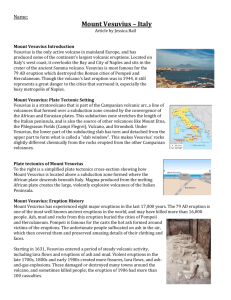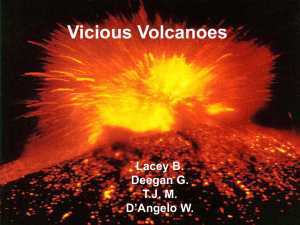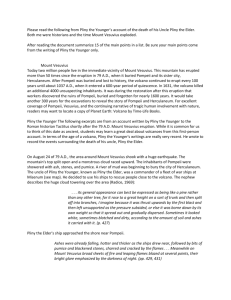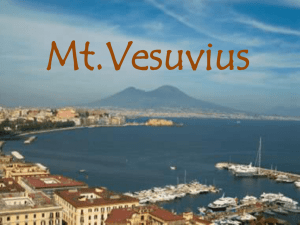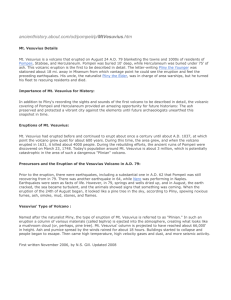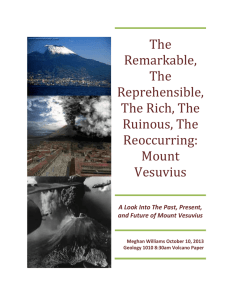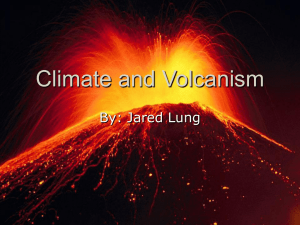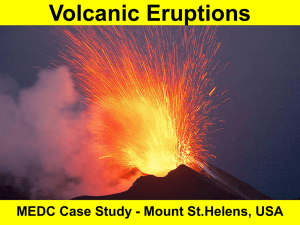An MEDC Stands for a more economically developed country. An
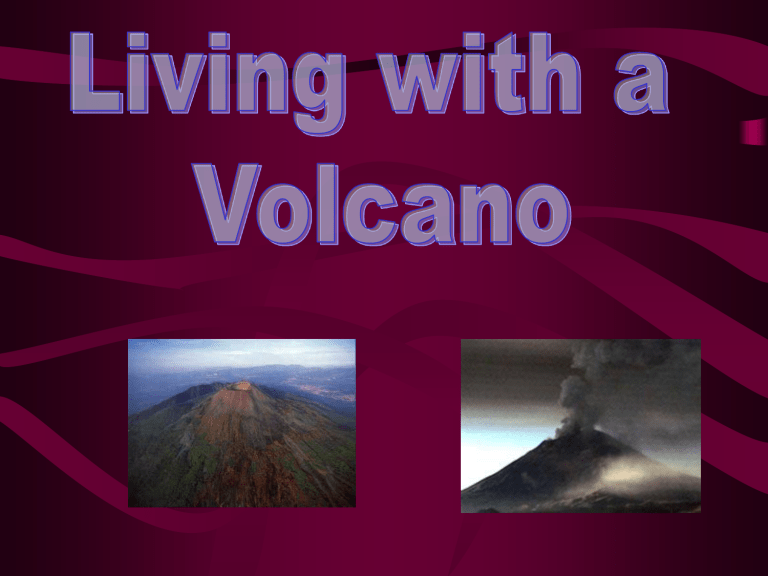
This project will give you information regarding two major volcanoes and the countries that they are in. In this project I am talking about Mount Vesuvius, this is situated in Naples in
Italy a MEDC the other volcano Mount Popocaepetl, situated in Mexico which is an LEDC .These are two totally different places and this is why I will be talking about them today. You may already know some of the information included but, hopefully you can learn something new from this project. I hope you enjoy this project so read on to find out more………
An MEDC Stands for a more economically developed country.
An example could be Spain or the United Kingdom.
It means that the country is richer so that it can afford more for the welfare of the whole population and things related to the country
Most of these countries are found in Europe or in the
USA on a whole
An LEDC stands for a less economically developed country.
An example could be Mexico or
Iceland.
It means that the country is not as developed and cannot afford as much as the income is lower than an MEDC for the people and the country on a whole.
It could be a Third World country in Africa, in parts of Asia or a country in South America.
•Mount Vesuvius lies in the Bay of Naples in South West of Italy.
•As you can see on the satellite view there is a dark area quite visible.This is called the Somma
Rim.
•This was formed by the collapse of a volcano 17,000 years ago.
•This is a short distance North
East of Vesuvius.
Mount Vesuvius is 4,200 feet high and is only one of the four active volcanoes in Italy.
2000 people are inhabitants in the area which is surrounding
Vesuvius.
Vesuvius is well know for the destructive eruption in 79 A.D, when it covered the towns
Herculaneum and Pompeii in deadly ash.
Vesuvius has erupted more than 50 times since 79 A.D
The view from a town by the waterfront near to Vesuvius
A satellite view showing the cone and crater of Vesuvius.
Mount Vesuvius never used to be an active volcano. For a long period of time it was described by ancient writers as been covered in gardens and vineyards, except at the peak and higher area of the mountain, where it was infertile, which means that farmers can not grow any crops and people can not make a living. No one knew what lay beyond this ‘peaceful mountain’.
In 5960 B.C and 3580 B.C Vesuvius erupted twice, recorded as some of the largest known in Europe, but even though they were one of the largest nothing would have prepared anyone for the eruption in 79 A.D
This picture shows a seismograph drum.
This enables scientists to look out for any changes in sound, which may help detect a volcano about to erupt.
•Over two million people live near Vesuvius today.One million of which are directly based around the mountain.
•Their lives could be in danger as Vesuvius could erupt at any time.
•So why do people live there? There is very good fertile land which is excellent for farming and people can make a living. Today it is covered in vineyards and gardens.
Vineyards which can produce things such as wine which can be sent to mainland or larger cities, so families can earn enough money to survive on.
•Even though there is always the risk of erupting at any time, people realise, but do not really have a choice.
•But it is either this, or living somewhere built up, with no land for crops.
There are many dangers living near to an active volcano, 1 million people today are within a high risk of danger and many more are at risk today. Here are only a few vital reasons;
In the first fifteen minutes in a medium to large scale eruption, in any areas within a four mile radius could easily be destroyed.
There are many roads and railways which are in a near radius to Vesuvius. These could be affected and are important means of transport for the people.
Vesuvius may be one of the major population density areas for volcanic activity on Earth, but is a very economically and cultured area.
It has a large population density and is getting more modernised by the day, including many more buildings,transport , homes etc…..
On August 24th 79 A.D came the unbelievable eruption that was the first ever volcanic eruption that was described in detail. Mount Vesuvius shook with a large earthquake shaking the whole area surrounding it. The force was so furious and the mountain top split open and a deadly cloud raised towards the sky spreading by the second. As the thick cloud spread to the neighbouring towns people were chaotic, not knowing what to do. Some escaped to the waterfront as it was their only hope, others stayed and prayed with hope.
As the cloud started to solidify , Pompeii was showered with ash, stones and pumice, growing larger in time. Roofs were buried and buildings collapsed, Pompeii was eventually covered in 3metres of tephra. But Herculaneum was buried in
23metres of ash which was let out by the pyroclastic flow. An estimated 3,360 people died from this terrible eruption.
Mount Popokatepetl is a 17,883 feet high, snowcapped stratovolcano.
It was given this name Popokatepetl, by the Aztecs which means smoking mountain.This suggests that it has been active for a long time.
It is the second highest volcano in
Mexico.
Popokatepetl’s most recent major eruption was in 1947, except that in
1994 it let out gas and ash , spreading to towns as far as a 25 mile radius.
Mount Popokatepetl is situated 45 miles southeast of Mexico City, and 30 miles south east of the city, Puebla.
Popokatepetl is often visible in good weather conditions, from the capital of
Mexico, Mexico City.
As you can see from the image, it is in the mainland of Mexico, which creates a large risk for people nearby.
Mexico City has a population density of 22million people. One of the largest in the world, and in risk if a large eruption takes place.
Popokatepetl is the most active volcano in Mexico as, even though it has been recorded to have erupted in
1347 and 1354 by the Aztecs, it has erupted 15 times since the Spanish arrival to Mexico in 1519. The eruptions in the past 600 years, were not major and only rose a few kilometres off the summit., letting out ash.
But on December 1 st 1994, some earthquakes were noticed and signalled that the eruption had started. A grey ash cloud was seen on top of the volcano, and later that day it fell on Pueblo.
The eruptions carried on throughout the afternoon, and soon 31,000 people were evacuated. By December 26 th
75, 000 people had been evacuated in total. Thankfully, it was not a large disaster, but today 20 million people are at risk
People live near volcanoes for various reasons.
Mexico is an extremely populated country, with one of the highest populated capital cities, with 20 million people.
Mount Popokatepetl has not ever erupted so fiercely to kill thousands of people , like Vesuvius, so people may not feel at a greater risk to move.
Mexico is an LEDC, which means that the income is lower and the welfare is not as good. People have to live here to earn enough money to produce good business.
Land is scarce, so to live near a volcano could be a last resort.
Volcanoes are a major tourist point, and the beauty attracts people, with the risks forgotten
So now you have read about both volcanoes. Each one is different in many ways.Vesuvius is an extremely complexed volcano. It has a lot of history and has had some serious eruptions in it time.But
Popocatepetl is complexed too,having had erupted at least 36 times! An MEDC and an
LEDC may seem similar, but the way of life is different. In a country like Italy, people may not struggle as much in life and have options where to live. But in Mexico, people have to earn a proper living, but some may not have a choice of where to live, so to inhabit a volcano is sometimes not an option…..
Effects of eruption of Vesuvius over
Pompeii and
Herculaneum
View of Vesuvius
In my opinion I think that living with a volcano would not be something that I would even consider! They may be a natural highlight of our world, but are not worth the risk. As even though technology has developed to predict a natural disaster, the volcano could ruin houses and peoples property or even death. Some people need to live near a volcano for the fertile land, but if a volcano would erupt, the work would be completely ruined………
